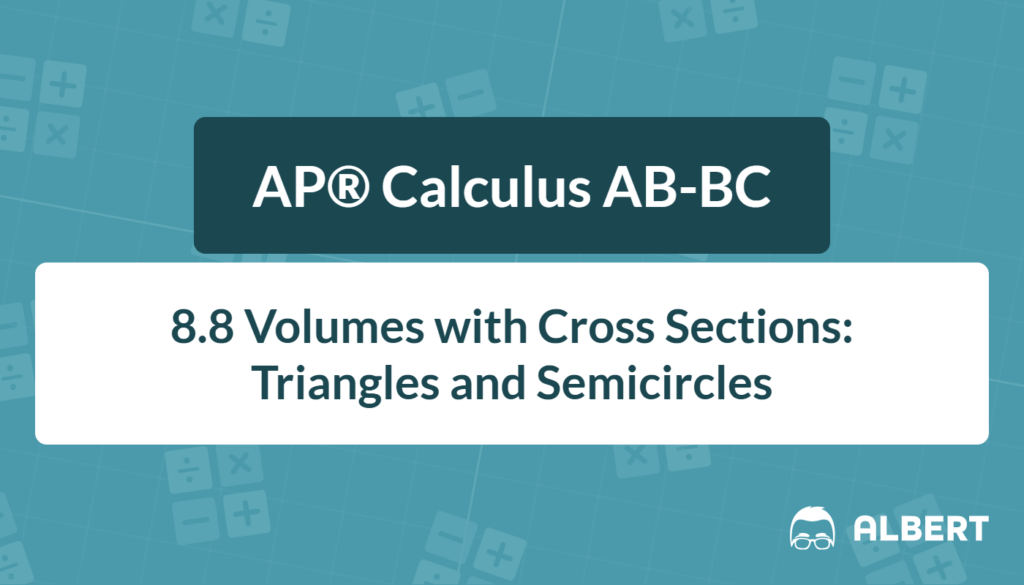Volumes created by slicing a region and stacking the slices appear often on the AP® Calculus exam. In the Course and Exam Description, these tasks live in Topic 8.8 “Volumes with Cross Sections” and in learning objectives CHA-5.B.2 and CHA-5.B.3. Therefore, knowing each cross-section area quickly saves time. This article highlights three popular shapes—semicircles, equilateral triangles, and squares—while focusing on the semicircle cross section formula. Clear examples and practice questions follow so that any student can master the process.
What We Review
Big Picture: From Slices to Solids
- A thin slice has volume ≈ (area of slice) × (thickness).
- Let the thickness be \Delta x or \Delta y. As the thickness shrinks to zero, Riemann sums become a definite integral.
- Consequently, the volume formula reads \displaystyle V = \int_{a}^{b} A(x)dx or \displaystyle V = \int_{c}^{d} A(y)dy.
Choosing the Correct Integral
- Decide whether slices are perpendicular to the x-axis or y-axis.
- Express the slice’s dimension (diameter, side, etc.) as a function.
- Use the region’s endpoints for the limits of integration.
Semicircle Cross Section Formula
Deriving the Area Expression
A full circle of radius r has area \pi r^{2}. A semicircle is half of that, so
A = \dfrac{1}{2}\pi r^{2}.In many AP® problems the given dimension is the diameter d. Because r = \dfrac{d}{2},
\displaystyle A(d) = \frac{1}{2}\pi\left(\frac{d}{2}\right)^{2}= \frac{\pi}{8d^{2}}.This key result is the semicircle cross section formula.
Step-by-Step Example
Region: Under y = \sqrt{4 - x^{2}} from x = -2 to x = 2. Slices are perpendicular to the x-axis and form semicircles.
1. Identify the diameter.
The curve describes a circle of radius 2 centered at the origin. For a fixed x, the top y-coordinate is \sqrt{4 - x^{2}} and the bottom is the x-axis (y=0). Therefore the slice’s height equals the diameter:
d(x) = \sqrt{4 - x^{2}}.2. Write the area of one slice.
A(x) = \frac{\pi}{8}[d(x)]^{2}= \frac{\pi}{8}\left(4 - x^{2}\right).3. Set up and evaluate the integral.
\displaystyle V = \int_{-2}^{2} \frac{\pi}{8}\left(4 - x^{2}\right)dx= \frac{\pi}{8}\int_{-2}^{2}(4 - x^{2})dx.Because the integrand is even, double the integral from 0 to 2:
\displaystyle V = \frac{\pi}{4}\int_{0}^{2}(4 - x^{2})dx= \frac{\pi}{4}\left[4x - \frac{x^{3}}{3}\right]_{0}^{2}= \frac{\pi}{4}\left(8 - \frac{8}{3}\right)= \frac{\pi}{4}\left(\frac{16}{3}\right)= \frac{4\pi}{3}.Therefore, the solid’s volume equals \dfrac{4\pi}{3}. A quick graph helps students envision the circle, the perpendicular slices, and the resulting dome-like solid.
Equilateral Triangle Cross Section Formula
An equilateral triangle with side s has area
A = \frac{\sqrt{3}}{4}s^{2}.Example
Region: Between the x-axis and y = 2 - x on 0 \le x \le 2. Cross sections perpendicular to the x-axis are equilateral triangles.
1. The side length equals the vertical distance from the curve to the axis:
s(x) = 2 - x.2. Thus A(x) = \frac{\sqrt{3}}{4}[2 - x]^{2}.
3. Volume calculation:
\displaystyle V = \int_{0}^{2}\frac{\sqrt{3}}{4}(2 - x)^{2}dx= \frac{\sqrt{3}}{4}\int_{0}^{2}(2 - x)^{2}dx.After expanding and integrating,
\displaystyle V= \frac{\sqrt{3}}{4}\left[\frac{(2 - x)^{3}}{-3}\right]_{0}^{2}= \frac{\sqrt{3}}{4}\left(\frac{8}{3}\right)= \frac{2\sqrt{3}}{3}.Consequently, the solid has volume \dfrac{2\sqrt{3}}{3}.
Square Cross Section Formula
Squares are straightforward. If the side length is s, then
A = s^{2}.Example
Region: Between y = x and y = 0 from x = 0 to x = 3. Cross sections are taken perpendicular to the y-axis, so express everything in terms of y.
- Solve y = x for x: x = y. The side length is the horizontal distance from x = y to x = 0, giving s(y) = y.
- The limits of integration run from y = 0 to y = 3.
- Hence, \displaystyle V = \int_{0}^{3} [s(y)]^{2}dy= \int_{0}^{3} y^{2}dy= \left[\frac{y^{3}}{3}\right]_{0}^{3}= 9.
Therefore, this square-based solid occupies 9 cubic units.
VPutting It All Together
Comparison of Cross Section Formulas
| Shape | Area Expression | Typical Variable |
| Semicircle | A = \dfrac{\pi}{8}d^{2} | diameter d |
| Equilateral Triangle | A = \dfrac{\sqrt{3}}{4}s^{2} | side s |
| Square | A = s^{2} | side s |
Common Setup Mistakes
- Forgetting to square the diameter or side before multiplying by the constant factor.
- Mixing x and y in the same integral; always choose one variable only.
- Using incorrect limits; therefore, always trace the original region first.
Checking these points before integrating avoids costly errors on CHA-5.B questions.
Quick Reference Vocabulary Chart
| Term | Brief Definition |
| Cross Section | 2-D slice of a solid taken perpendicular to an axis |
| Semicircle Cross Section Formula | A = \frac{\pi}{8}d^{2} |
| Equilateral Triangle Cross Section Formula | A = \frac{\sqrt{3}}{4}s^{2} |
| Square Cross Section Formula | A = s^{2} |
| Definite Integral | Limit of Riemann sums; computes net area or accumulated quantity |
Conclusion
Slicing a region and stacking the pieces turns a plane figure into a three-dimensional solid. The semicircle cross section formula, along with the equilateral triangle and square versions, streamlines the calculation. Mastery of these expressions fulfills CHA-5.B.2 and CHA-5.B.3 expectations and boosts confidence during Topic 8.8 volumes with cross sections. For continued practice, explore additional review articles or released AP® free-response questions featuring composite shapes and rotated solids.
Sharpen Your Skills for AP® Calculus AB-BC
Are you preparing for the AP® Calculus exam? We’ve got you covered! Try our review articles designed to help you confidently tackle real-world math problems. You’ll find everything you need to succeed, from quick tips to detailed strategies. Start exploring now!
- 8.7 Volumes with Cross Sections: Squares and Rectangles
- 8.9 Volume with Disc Method: Revolving Around the x- or y-Axis
Need help preparing for your AP® Calculus AB-BC exam?
Albert has hundreds of AP® Calculus AB-BC practice questions, free responses, and an AP® Calculus AB-BC practice test to try out.








